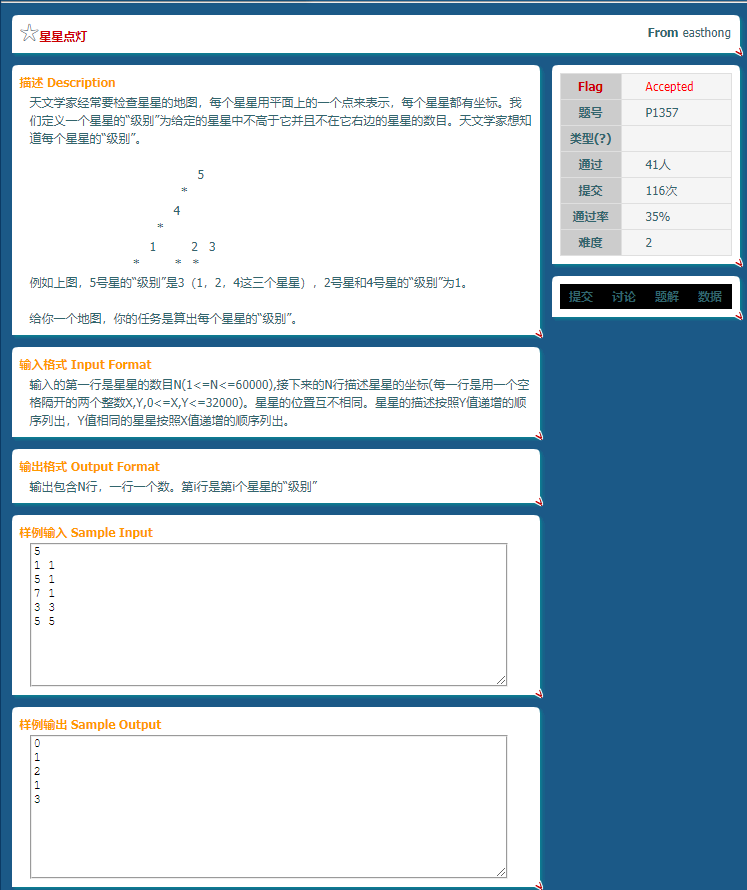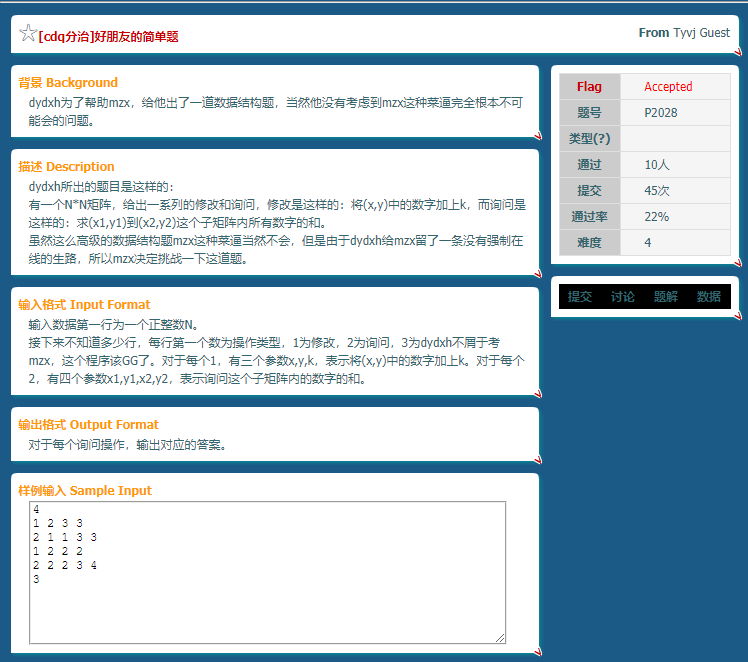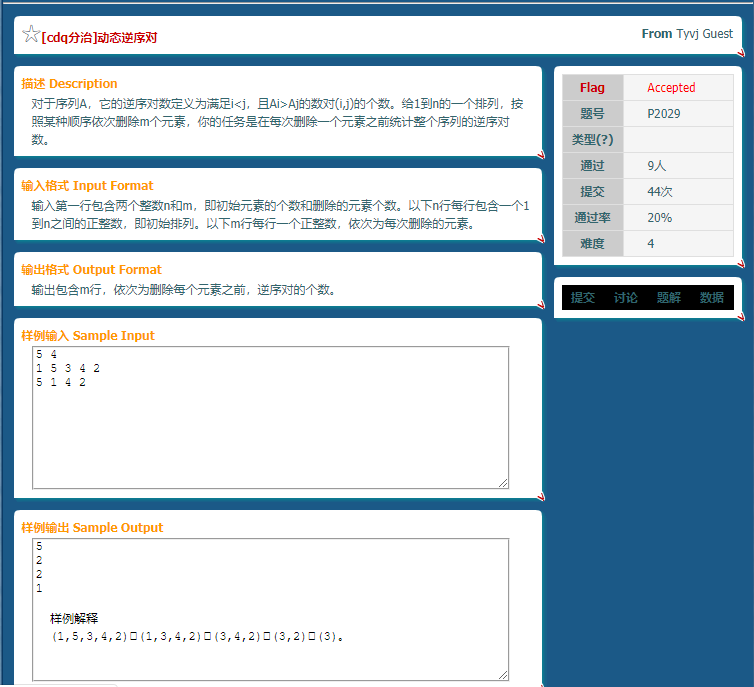多方查找找到了2008年陈丹琪引入CDQ分治的 从《Cash》谈一类分治算法的应用.doc ,CDQ分治的名字由来也是她.
什么叫CDQ分治呢?来看一道二维数点题p1357.

看了一眼题,我会树状数组!
现在拿它来引入CDQ分治.先全部按照x排序,由于区间[mid+1,r]不会再对区间[l,mid]有贡献,对于区间[l,r]内的贡献都可以分三步进行.
1.算区间[l,mid]内部相互的贡献
2.算区间[mid+1,r]内部相互的贡献
3.算[l,mid]对于[mid+1,r]的贡献
现在考虑如何更快的计算第3步?假设1,2步后,两个小区间内部变成了按y排序的,我们像归并一样的把两个小区间按y合并成一个大区间并得到[l,mid]对于[mid+1,r]的贡献.
先放一个nlog^2n的算法

bool Orz(node a,node b) { return a.x<b.x; } void CDQ(int l,int r) { if(l==r) return ;//自己对自己当然没贡献了 int mid=(l+r)/2; CDQ(l,mid); CDQ(mid+1,r); //简陋的树状数组实现贡献统计 for(int i=l;i<=mid;i++)//怎么还用树状数组啊? add(o[i].y,1); for(int i=mid+1;i<=r;i++) ans[o[i].i]+=ask(o[i].y);//算贡献 for(int i=l;i<=mid;i++)//怎么又减回去了啊? add(o[i].y,-1); sort(o+l,o+r+1);//简陋的sort排序 } int main() { freopen("123.in","r",stdin); n=read(); for(i=1;i<=n;i++) { o[i].x=read(); o[i].y=read(); o[i].i=i;//记录原始位置 } sort(o+1,o+1+n,Orz); CDQ(1,n);//调用分治 for(i=1;i<=n;i++) cout<<ans[i]<<endl; }
再放一个好看的

struct node { int x,y; int i; }o[60010],temp[60010]; int ans[60010]; int i,n; inline bool Orz(node a,node b) { return a.x==b.x?a.y<b.y:a.x<b.x; } inline void CDQ(int l,int r) { if(l==r) return ;//自己对自己当然没贡献了 int mid=(l+r)/2; CDQ(l,mid); CDQ(mid+1,r); int a=l,b=mid+1,tot=l; for(;a<=mid||b<=r;tot++)//合并区间并统计答案 { if(a<=mid&&o[a].y<=o[b].y||b>r) { temp[tot]=o[a]; a++; } else { ans[o[b].i]+=a-l;//统计答案 temp[tot]=o[b]; b++; } } for(int i=l;i<=r;i++) o[i]=temp[i]; } int main() { n=read(); for(i=1;i<=n;i++) { o[i].x=read(); o[i].y=read(); o[i].i=i;//记录原始位置 } sort(o+1,o+1+n,Orz); CDQ(1,n);//调用分治 for(i=1;i<=n;i++) { write(ans[i]); putchar(10); } }
用CDQ A掉后可以去p2026交一下.可以看到两道题几乎一样,区别在于aibi的范围.但是离散化也能写啊QAQ
然后来看一个三位数点问题.


首先题目有些不一样了,假设随从i可以完爆f(i)个随从,本题询问的是f()=i的数量.
然后来做题.
为了继续套用CDQ的模板,我们可先按照x,y,z为第一,二,三关键字从小到大进行排序,这样可以保证任意区间[l,r]内的右区间不会对左区间产生贡献.为了O(r-l)的决策贡献,我们可以使得CDQ()两个子区间后,每个区间内部都是以y为第一关键字进行排序,然后继续按照归并排序的方法合并两个区间并计算贡献,具体计算方法也不一样了,并且y的单调性并不能保证z的单调性,我们需要树状数组了.

int i; int n,c[200010],ans[100010],cnt[100010]; struct node { int x,y,z; int i; }o[100010],temp[100010]; inline int lowbit(int x) { return x&(-x); } inline void add(int x,int k) { while(x<=200000) { c[x]+=k; x+=lowbit(x); } } inline int ask(int x) { int sum=0; while(x) { sum+=c[x]; x-=lowbit(x); } return sum; } inline bool Orz(node a,node b) { return a.x==b.x?(a.y==b.y?(a.z==b.z?a.i<b.i:a.z<b.z):a.y<b.y):a.x<b.x; } void CDQ(int l,int r) { if(l==r) return ; int mid=(l+r)/2; CDQ(l,mid); CDQ(mid+1,r); int a=l,b=mid+1,tot=l; for(;a<=mid||b<=r;tot++) { if(a<=mid&&(o[a].y<o[b].y||(o[a].y==o[b].y&&o[a].z<o[b].z)||(o[a].y==o[b].y&&o[a].z==o[b].z&&o[a].x<o[b].x))||b>r) { temp[tot]=o[a]; add(o[a].z,1); a++; } else { ans[o[b].i]+=ask(o[b].z); temp[tot]=o[b]; b++; } } while(a>l) { a--; add(o[a].z,-1); } for(tot=l;tot<=r;tot++) o[tot]=temp[tot]; } int main() { n=read();i=read(); for(i=1;i<=n;i++) { o[i].x=read(); o[i].y=read(); o[i].z=read(); o[i].i=i; } sort(o+1,o+1+n,Orz); CDQ(1,n); for(i=1;i<=n;i++) cnt[ans[i]]++; for(i=0;i<n;i++) { write(cnt[i]); putchar(10); } }
这个代码在洛谷上仍然过不了,在本校oj上倒是跑的很好.这说明我的代码还是很糙...//2019 2 20 14:37
不管了我们继续.


又有了一道CDQ.看一眼题目,是带修改的离线二维数点,如何来做呢?
先考虑如何读入.
当然是仁者见仁智者见智了.反正修改和询问是要平等的放在同一个数组(结构体)里的.我的方法是存在结构体里,并把询问拆成四个(假设x2>=x1,y2>=y1)sum(x2,y2)+sum(x1-1,y1-1)-sum(x2,y1-1)-sum(x1-1,y2).存一个i表示时间戳.并把询问的flag设为1,修改的flag设为0.
然后可以发现,一个区间查询sum(x,y)等价于 "查询所有时间戳小于它且x小于等于它且y小于等于它的flag=0的点的权和".这个和三维偏序好像啊,CDQ+树状数组A掉.

int i,T,tx1,tx2,ty1,ty2; int n,tot,c[500010]; struct node { int x,y; int i,sum; int flag; }o[800010],temp[800010];//操作数*4 int lowbit(int x) { return x&(-x); } inline void add(int x,int k) { while(x<=n) { c[x]+=k; x+=lowbit(x); } } inline int ask(int x) { int sum=0; while(x) { sum+=c[x]; x-=lowbit(x); } return sum; } void CDQ(int l,int r) { if(l==r) return ; int mid=(l+r)/2,t=l,a=l,b=mid+1; CDQ(l,mid); CDQ(mid+1,r); for(;a<=mid||b<=r;t++) { if(a<=mid&&o[a].x<=o[b].x||b>r)//如果a可以用且a的x小于等于b的x或b不能用 { temp[t]=o[a]; if(!o[a].flag) add(o[a].y,o[a].sum); a++; } //else if(b<=r&&o[a].x>o[b].x||a>mid) else//如果b的x小于a的x或a不能用 { if(o[b].flag) o[b].sum+=ask(o[b].y); temp[t]=o[b]; b++; } } //从上面的if可以发现y的大小不会影响答案 for(a=l;a<=mid;a++) if(!o[a].flag) add(o[a].y,-o[a].sum); for(t=l;t<=r;t++) o[t]=temp[t]; return ; } inline bool Orz(node a,node b) { return a.i<b.i; } int main() { n=read(); for(T=read();T!=3;T=read()) { tot++; if(T==1) { o[tot].x=read(); o[tot].y=read(); o[tot].sum=read(); o[tot].i=tot; //o[tot].flag=0; } else { tx1=read();ty1=read();tx2=read();ty2=read(); //下面的min,max是为了防止不合法数据.. o[tot].x=min(tx1,tx2)-1; o[tot].y=min(ty1,ty2)-1; o[tot].i=tot; o[tot].flag=1; tot++; o[tot].x=max(tx1,tx2); o[tot].y=max(ty1,ty2); o[tot].i=tot; o[tot].flag=1; tot++; o[tot].x=max(tx1,tx2); o[tot].y=min(ty1,ty2)-1; o[tot].i=tot; o[tot].flag=1; tot++; o[tot].x=min(tx1,tx2)-1; o[tot].y=max(ty1,ty2); o[tot].i=tot; o[tot].flag=1; } } //这道"三维偏序"不需要事先sort了,因为有一维i有序了 CDQ(1,tot); //这里的o一定是以x为第一关键字排列的,第二关键字不太清楚也不太重要 sort(o+1,o+1+tot,Orz);//恢复原排列 for(i=1;i<=tot;) if(o[i].flag) { write(o[i].sum+o[i+1].sum-o[i+2].sum-o[i+3].sum);// putchar(10); i+=4; } else i++; return 0; }
继续继续.


看到题目,逆序对?我会树状数组!
动态的?n^2logn!
我瞎说的.
读入的时候进行一番操作,可以继续记录每个点的权值为x,位置为i,被删除的时间戳t(最后也没被删去的设为n+1好了).那么可以算每个点的答案为.x1>x&&i1<i&&t1<=t和x1<x&&i1>i&&t1<=t的数量.可以发现t1=t的那部分重复了.我们需要一个简单容斥.这样一处理就又是三维偏序了?我们可以自豪的说出:我会CDQ!
具体来说,大家可以先写个n^2的暴力,过样例后再调用CDQ写个暴力,再用CDQ写个更好的算法.
我也会用一晚上的时间搞出多个版本放在下面.

int i,tx; int n,m,c[100010]; inline int lowbit(int x) { return x&(-x); } inline void add(int x,int k) { while(x<=n) { c[x]+=k; x+=lowbit(x); } } inline int ask(int x) { int sum=0; while(x) { sum+=c[x]; x-=lowbit(x); } return sum; } struct node { int x,i,t;//权值,位置,时间 int ans; }o[100010],temp[100010]; bool x_(node a,node b) { return a.x<b.x; } bool t_(node a,node b) { return a.t<b.t; } int main() { freopen("123.in","r",stdin); n=read();m=read(); for(i=1;i<=n;i++) { o[i].x=read(); o[i].i=i; o[i].t=m+1; } sort(o+1,o+1+n,x_); for(i=1;i<=m;i++) { tx=read(); o[tx].t=i; } sort(o+1,o+1+n,t_); for(int a=1;a<=m;a++) { for(int b=a+1;b<=n;b++) { if(o[a].x>o[b].x&&o[a].i<o[b].i||o[a].x<o[b].x&&o[a].i>o[b].i) { o[a].ans++; } } //cout<<o[a].ans<<endl; } for(int a=m+1;a<=n;a++) { for(int b=a+1;b<=n;b++) { if(o[a].x>o[b].x&&o[a].i<o[b].i||o[a].x<o[b].x&&o[a].i>o[b].i) { o[m+1].ans++; } } } for(i=m;i;i--) { o[i].ans+=o[i+1].ans; } for(i=1;i<=m;i++) { cout<<o[i].ans<<endl; } }

int i,tx; int n,m,c[100010]; inline int lowbit(int x) { return x&(-x); } inline void add(int x,int k) { while(x<=n) { c[x]+=k; x+=lowbit(x); } } inline int ask(int x) { int sum=0; while(x) { sum+=c[x]; x-=lowbit(x); } return sum; } struct node { int x,i,t;//权值,位置,时间 int ans; }o[100010],temp[100010]; int sum; bool x_(node a,node b) { return a.x<b.x; } bool t_(node a,node b) { return a.t<b.t; } void three() { for(int a=1;a<=m;a++) for(int b=a+1;b<=n;b++) if(o[a].x>o[b].x&&o[a].i<o[b].i) o[a].ans++; for(int a=1;a<=m;a++) for(int b=a+1;b<=n;b++) if(o[a].x<o[b].x&&o[a].i>o[b].i) o[a].ans++; } void two(int l,int r) { sort(o+1,o+1+n,t_); sort(o+l,o+r+1,x_); for(int a=l;a<=r;a++) { sum+=a-l-ask(o[a].i); add(o[a].i,1); } memset(c,0,sizeof(c)); } int main() { // freopen("123.in","r",stdin); n=read();m=read(); for(i=1;i<=n;i++) { o[i].x=read(); o[i].i=i; o[i].t=m+1; } sort(o+1,o+1+n,x_); for(i=1;i<=m;i++) { tx=read(); o[tx].t=i; } two(m+1,n); sort(o+1,o+1+n,t_); three(); sort(o+1,o+1+n,t_); o[m+1].ans=sum; for(i=m;i;i--) o[i].ans+=o[i+1].ans; for(i=1;i<=m;i++) cout<<o[i].ans<<endl; }

int sum; bool x_(node a,node b) { return a.x<b.x; } bool _x(node a,node b) { return a.x>b.x; } bool t_(node a,node b) { return a.t<b.t; } void CDQ1(int l,int r) { if(l==r) return ; int mid=(l+r)/2,a=l,b=mid+1,tot=l; CDQ1(l,mid); CDQ1(mid+1,r); for(;a<=mid||b<=r;tot++) if(a<=mid&&o[a].x<o[b].x||b>r) { o[a].ans+=b-mid-1-ask(o[a].i); temp[tot]=o[a]; a++; } else { add(o[b].i,1); temp[tot]=o[b]; b++; } for(b=mid+1;b<=r;b++) add(o[b].i,-1); for(tot=l;tot<=r;tot++) o[tot]=temp[tot]; } void CDQ2(int l,int r) { if(l==r) return ; int mid=(l+r)/2,a=l,b=mid+1,tot=l; CDQ2(l,mid); CDQ2(mid+1,r); for(;a<=mid||b<=r;tot++) if(a<=mid&&o[a].x>o[b].x||b>r) { o[a].ans+=ask(o[a].i); temp[tot]=o[a]; a++; } else { add(o[b].i,1); temp[tot]=o[b]; b++; } for(b=mid+1;b<=r;b++) add(o[b].i,-1); for(tot=l;tot<=r;tot++) o[tot]=temp[tot]; } void three() { CDQ1(1,m); /*for(int a=1;a<=m;a++) for(int b=a+1;b<=m;b++) if(o[a].x>o[b].x&&o[a].i<o[b].i) o[a].ans++;*/ sort(o+1,o+1+n,t_); CDQ2(1,m); sort(o+1,o+1+n,t_); for(int a=1;a<=m;a++) for(int b=m+1;b<=n;b++) if(o[a].x>o[b].x&&o[a].i<o[b].i) o[a].ans++; for(int a=1;a<=m;a++) for(int b=m+1;b<=n;b++) if(o[a].x<o[b].x&&o[a].i>o[b].i) o[a].ans++; } void two(int l,int r) { sort(o+1,o+1+n,t_); sort(o+l,o+r+1,x_); for(int a=l;a<=r;a++) { sum+=a-l-ask(o[a].i); add(o[a].i,1); } memset(c,0,sizeof(c)); } int main() { freopen("123.in","r",stdin); n=read();m=read(); for(i=1;i<=n;i++) { o[i].x=read(); o[i].i=i; o[i].t=m+1; } sort(o+1,o+1+n,x_); for(i=1;i<=m;i++) { tx=read(); o[tx].t=i; } two(m+1,n); sort(o+1,o+1+n,t_); three(); sort(o+1,o+1+n,t_); o[m+1].ans=sum; for(i=m;i;i--) o[i].ans+=o[i+1].ans; for(i=1;i<=m;i++) cout<<o[i].ans<<endl; }

#include<iostream> #include<iomanip> #include<cstdio> #include<cstdlib> #include<cstring> #include<cmath> #include<string> #include<algorithm> #include<vector> #include<map> #include<stack> #include<queue> #include<deque> #include<set> using namespace std; char buf[1<<15],*fs,*ft; inline char getc(){ return (fs==ft&&(ft=(fs=buf)+fread(buf,1,1<<15,stdin),fs==ft))?0:* fs++; } inline int read(){ int This=0,F=1; char ch=getc(); while(ch<'0'||ch>'9'){ if(ch=='-') F=-1; ch=getc(); } while(ch>='0'&&ch<='9'){ This=(This<<1)+(This<<3)+ch-'0'; ch=getc(); } return This*F; } inline void write(int x) { if(x==0) { putchar('0'); return; } if(x<0) { putchar('-'); x=-x; } int num=0;char ch[16]; while(x) ch[++num]=x%10+'0',x/=10; while(num) putchar(ch[num--]); } int i,tx; int n,m,c[100010]; inline int lowbit(int x) { return x&(-x); } inline void add(int x,int k) { while(x<=n) { c[x]+=k; x+=lowbit(x); } } inline int ask(int x) { int sum=0; while(x) { sum+=c[x]; x-=lowbit(x); } return sum; } struct node { int x,i,t;//权值,位置,时间 int ans; }o[100010],temp[100010]; int sum; bool x_(node a,node b) { return a.x<b.x; } bool _x(node a,node b) { return a.x>b.x; } bool t_(node a,node b) { return a.t<b.t; } void CDQ1(int l,int r) { if(l==r) return ; int mid=(l+r)/2,a=l,b=mid+1,tot=l; CDQ1(l,mid); CDQ1(mid+1,r); for(;a<=mid||b<=r;tot++) if(a<=mid&&o[a].x<o[b].x||b>r) { o[a].ans+=b-mid-1-ask(o[a].i); temp[tot]=o[a]; a++; } else { add(o[b].i,1); temp[tot]=o[b]; b++; } for(b=mid+1;b<=r;b++) add(o[b].i,-1); for(tot=l;tot<=r;tot++) o[tot]=temp[tot]; } void CDQ2(int l,int r) { if(l==r) return ; int mid=(l+r)/2,a=l,b=mid+1,tot=l; CDQ2(l,mid); CDQ2(mid+1,r); for(;a<=mid||b<=r;tot++) if(a<=mid&&o[a].x>o[b].x||b>r) { o[a].ans+=ask(o[a].i); temp[tot]=o[a]; a++; } else { add(o[b].i,1); temp[tot]=o[b]; b++; } for(b=mid+1;b<=r;b++) add(o[b].i,-1); for(tot=l;tot<=r;tot++) o[tot]=temp[tot]; } void three() { CDQ1(1,m); /*for(int a=1;a<=m;a++) for(int b=a+1;b<=m;b++) if(o[a].x>o[b].x&&o[a].i<o[b].i) o[a].ans++;*/ sort(o+1,o+1+n,t_); CDQ2(1,m); sort(o+1,o+1+n,t_); sort(o+1,o+1+m,x_); sort(o+1+m,o+n+1,x_); int a=1,b=m+1; for(;a<=m||b<=n;) { if(a<=m&&o[a].x<o[b].x||b>n) { o[a].ans+=b-m-1-ask(o[a].i); a++; } else { add(o[b].i,1); b++; } } memset(c,0,sizeof(c)); sort(o+1,o+1+m,_x); sort(o+1+m,o+1+n,_x);/* sort(o+1,o+1+n,t_); for(int a=1;a<=m;a++) for(int b=m+1;b<=n;b++) if(o[a].x<o[b].x&&o[a].i>o[b].i) o[a].ans++;*/ for(a=1,b=m+1;a<=m||b<=n;) { if(a<=m&&o[a].x>o[b].x||b>n) { o[a].ans+=ask(o[a].i); a++; } else { add(o[b].i,1); b++; } } sort(o+1,o+1+n,t_); } void two(int l,int r) { sort(o+1,o+1+n,t_); sort(o+l,o+r+1,x_); for(int a=l;a<=r;a++) { sum+=a-l-ask(o[a].i); add(o[a].i,1); } memset(c,0,sizeof(c)); } int main() { // freopen("123.in","r",stdin); n=read();m=read(); for(i=1;i<=n;i++) { o[i].x=read(); o[i].i=i; o[i].t=m+1; } sort(o+1,o+1+n,x_); for(i=1;i<=m;i++) { tx=read(); o[tx].t=i; } two(m+1,n); sort(o+1,o+1+n,t_); three(); sort(o+1,o+1+n,t_); o[m+1].ans=sum; for(i=m;i;i--) o[i].ans+=o[i+1].ans; for(i=1;i<=m;i++) { write(o[i].ans); putchar(10); } }

long long i,tx; long long n,m,c[100010]; inline long long lowbit(long long x) { return x&(-x); } inline void add(long long x,long long k) { while(x<=n) { c[x]+=k; x+=lowbit(x); } } inline long long ask(long long x) { long long sum=0; while(x) { sum+=c[x]; x-=lowbit(x); } return sum; } struct node { long long x,i,t;//权值,位置,时间 long long ans; }o[100010],temp[100010]; long long sum; inline bool x_(node a,node b) { return a.x<b.x; } inline bool _x(node a,node b) { return a.x>b.x; } inline bool t_(node a,node b) { return a.t<b.t; } void CDQ1(long long l,long long r) { if(l==r) return ; long long mid=(l+r)/2,a=l,b=mid+1,tot=l; CDQ1(l,mid); CDQ1(mid+1,r); for(;a<=mid||b<=r;tot++) if(a<=mid&&o[a].x<o[b].x||b>r) { o[a].ans+=b-mid-1-ask(o[a].i); temp[tot]=o[a]; a++; } else { add(o[b].i,1); temp[tot]=o[b]; b++; } for(b=mid+1;b<=r;b++) add(o[b].i,-1); for(tot=l;tot<=r;tot++) o[tot]=temp[tot]; } void CDQ2(long long l,long long r) { if(l==r) return ; long long mid=(l+r)/2,a=l,b=mid+1,tot=l; CDQ2(l,mid); CDQ2(mid+1,r); for(;a<=mid||b<=r;tot++) if(a<=mid&&o[a].x>o[b].x||b>r) { o[a].ans+=ask(o[a].i); temp[tot]=o[a]; a++; } else { add(o[b].i,1); temp[tot]=o[b]; b++; } for(b=mid+1;b<=r;b++) add(o[b].i,-1); for(tot=l;tot<=r;tot++) o[tot]=temp[tot]; } void three() { CDQ1(1,m); sort(o+1,o+1+n,t_); CDQ2(1,m); sort(o+1,o+1+n,t_); sort(o+1,o+1+m,x_); sort(o+1+m,o+n+1,x_); long long a=1,b=m+1; for(;a<=m||b<=n;) if(a<=m&&o[a].x<o[b].x||b>n) { o[a].ans+=b-m-1-ask(o[a].i); a++; } else { add(o[b].i,1); b++; } memset(c,0,sizeof(c)); sort(o+1,o+1+m,_x); sort(o+1+m,o+1+n,_x); for(a=1,b=m+1;a<=m||b<=n;) if(a<=m&&o[a].x>o[b].x||b>n) { o[a].ans+=ask(o[a].i); a++; } else { add(o[b].i,1); b++; } sort(o+1,o+1+n,t_); } void two(long long l,long long r) { sort(o+1,o+1+n,t_); sort(o+l,o+r+1,x_); for(long long a=l;a<=r;a++) { sum+=a-l-ask(o[a].i); add(o[a].i,1); } memset(c,0,sizeof(c)); } int main() { n=read();m=read(); for(i=1;i<=n;i++) { o[i].x=read(); o[i].i=i; o[i].t=m+1; } sort(o+1,o+1+n,x_); for(i=1;i<=m;i++) { tx=read(); o[tx].t=i; } two(m+1,n); sort(o+1,o+1+n,t_); three(); sort(o+1,o+1+n,t_); o[m+1].ans=sum; for(i=m;i;i--) o[i].ans+=o[i+1].ans; for(i=1;i<=m;i++) { write(o[i].ans); putchar(10); } }
最终的版本实现方式:先二维偏序sort+树状数组解决(m,n]内的贡献记在sum里 ,最后给o[m+1].ans,并用两次三维偏序解决[1,n]内部的贡献,再跑一边归并计算出(m,n]对[1,n]的贡献.逆序跑一遍后缀和后正序输出.
